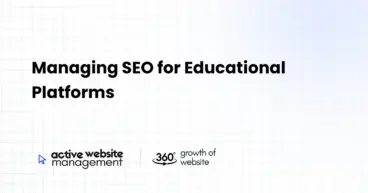December 18, 2024
8 min read
Search Engine Optimization (SEO) is the cornerstone of digital marketing. Whether you’re running a blog, a business site, or an e-commerce store, ensuring that your WordPress website is SEO-friendly is essential for driving organic traffic. On-Page SEO refers to the practices that can be implemented directly on your website to improve its visibility in search engines like Google, Bing, and Yahoo. These are actions taken within your website’s content, code, and structure.
In this comprehensive guide, we’ll cover the essential on-page SEO elements every WordPress website should optimize to improve its search engine rankings. By following the best practices outlined here, you can enhance your site’s discoverability, improve user experience, and ultimately drive more traffic and conversions.
1. What is On-Page SEO?
On-Page SEO refers to the various factors on a webpage that you can optimize to improve its ranking in search engine results. This includes content, HTML source code, title tags, meta descriptions, and more. Unlike off-page SEO, which involves external factors like backlinks, on-page SEO focuses on elements you can directly control within your website.
For WordPress users, on-page SEO is especially crucial because of its flexibility and the number of tools available to optimize your website.
2. Why On-Page SEO Matters
On-page SEO is fundamental for ensuring that your website content can be found and indexed by search engines. Search engines aim to provide users with the most relevant and high-quality content. When you optimize your WordPress site’s on-page SEO, you signal to search engines that your content is valuable and relevant to users’ search queries.
Here are a few reasons why on-page SEO is so important:
- Increased Visibility: Properly optimized pages are more likely to rank higher in search engine results.
- Enhanced User Experience: Well-optimized pages load faster, are easier to navigate, and provide more value to the user.
- Higher Conversion Rates: By aligning your content with user intent, you can drive more targeted traffic to your site and improve conversions.
- Better User Engagement: Optimizing for readability and performance can reduce bounce rates and increase engagement.
3. On-Page SEO Essentials for WordPress
To master on-page SEO for WordPress websites, there are several key components that need your attention. Let’s break them down:
Don’t Just Maintain Your Website—
Grow It using Active Website Management! Don't Wait for Growth—Accelerate It with Active Website Management
3.1 Keyword Research: The Foundation of On-Page SEO
Before you can optimize any page, you need to know what keywords your target audience is searching for. Keyword research is the foundation of all SEO efforts. By identifying the right keywords, you can tailor your content to meet the needs of your audience and improve the chances of ranking higher.
Best Practices for Keyword Research:
- Use tools like Google Keyword Planner or Ahrefs to identify keywords with high search volume and low competition.
- Focus on long-tail keywords (phrases with 3+ words) for more specific searches.
- Include keywords naturally in your content, without keyword stuffing.
Learn more about the importance of keyword research for your website in this SEO tips guide.
The title tag is one of the most important on-page SEO elements because it tells search engines and users what your page is about. Your title tag should be concise, relevant, and include your target keyword.
Best Practices for Title Tags:
- Keep it under 60 characters to ensure it’s displayed fully in search results.
- Place the target keyword near the beginning of the title.
- Write compelling titles that encourage clicks.
Example:
- SEO-friendly Title: “On-Page SEO Essentials for WordPress Websites: A Complete Guide”
- Non-SEO-friendly Title: “Welcome to Our Blog”
Meta descriptions are the short snippets that appear under your page title in search engine results. Though they don’t directly affect rankings, they play a crucial role in increasing the click-through rate (CTR). Crafting an enticing and keyword-rich meta description can attract more visitors to your website.
Best Practices for Meta Descriptions:
- Keep the length between 150-160 characters.
- Include your primary keyword naturally.
- Make it actionable, such as using phrases like “Learn more” or “Discover how.”
- Use a unique meta description for each page.
Example:
- SEO-friendly Meta Description: “Discover essential on-page SEO techniques for WordPress websites. Improve rankings and user experience with these actionable tips!”
3.4 Headings: Organizing Content for SEO
Headings (H1, H2, H3, etc.) are used to structure your content and make it easier for both users and search engines to understand. The H1 tag is the most important, followed by H2s and H3s. Properly using headings helps search engines to index your content better, and it also enhances readability for users.
Best Practices for Headings:
- Use one H1 tag per page, typically for the main title.
- Break your content into sections with H2s and H3s to improve readability.
- Include your target keywords in at least one or two subheadings.
3.5 URL Structure: Keep It Simple and Descriptive
The URL of a page is a critical factor for both SEO and user experience. Clean and descriptive URLs help both search engines and users understand what a page is about.
Best Practices for URL Structure:
- Keep URLs short, clear, and descriptive.
- Include your target keyword.
- Use hyphens to separate words (e.g., /on-page-seo-essentials).
- Avoid using special characters, unnecessary parameters, or numbers in URLs.
3.6 Content Optimization: Quality Over Quantity
Content is the core of any SEO strategy. High-quality content not only provides value to users but also helps improve your rankings. Google rewards websites that consistently publish relevant, high-quality content.
Best Practices for Content Optimization:
- Write for your audience first, not search engines.
- Use your primary keyword naturally throughout the content.
- Aim for comprehensive, well-researched content that answers user questions.
- Avoid keyword stuffing—use synonyms and related terms to keep the content natural.
3.7 Internal Linking: Strengthening Your Site’s Architecture
Internal linking is crucial for both SEO and user navigation. It allows search engines to crawl your website more efficiently and helps users navigate between related pages.
Best Practices for Internal Linking:
- Link to relevant articles or pages within your website.
- Use descriptive anchor text that provides context for the link.
- Don’t overdo it—too many internal links can look spammy.
3.8 Image Optimization: Enhancing User Experience and Speed
Images play an essential role in user experience, but they can also slow down your website if not optimized. Optimizing images helps improve page load speeds and accessibility while enhancing SEO.
Best Practices for Image Optimization:
- Compress images to reduce their file size without sacrificing quality.
- Use descriptive file names (e.g., “seo-tips-for-wordpress.jpg”).
- Add ALT text to all images for better accessibility and SEO.
- Choose the right image format (e.g., JPEG for photos, PNG for graphics).
Don't Wait for Growth—Accelerate It with
Active Website Management Don't Wait for Growth—Accelerate It with Active Website Management
3.9 Mobile Optimization: Making Your Site Mobile-Friendly
With more users accessing websites through mobile devices, it’s crucial that your WordPress site is fully optimized for mobile. Google uses mobile-first indexing, meaning that the mobile version of your website is prioritized for ranking.
Best Practices for Mobile Optimization:
- Use responsive themes that adjust to different screen sizes.
- Ensure your pages load quickly on mobile devices.
- Avoid intrusive pop-ups or interstitials that hinder mobile user experience.
4. Active Website Management for SEO Success
Active Wrbsite Management. SEO is not a one-time task but an ongoing process. Regularly monitoring your website’s performance, updating outdated content, and keeping track of emerging SEO trends are essential for long-term success.
5. How to Track Your On-Page SEO Success
Tools like Google Analytics and Google Search Console provide valuable insights into how well your pages are performing. Monitor metrics like organic traffic, bounce rate, and conversion rate to determine the effectiveness of your SEO efforts.
6. Common On-Page SEO Mistakes to Avoid
- Keyword Stuffing: Overusing keywords can make your content sound unnatural and may result in a penalty.
- Ignoring Mobile Optimization: With mobile usage increasing, a non-mobile-friendly website can hurt your rankings.
- Neglecting Image Optimization: Unoptimized images can slow down your site and impact user experience.
7. Conclusion
On-page SEO is the foundation of a successful digital marketing strategy. By implementing these essential techniques, you’ll improve your WordPress site’s search engine visibility, enhance user experience, and drive more traffic to your site. Regularly reviewing and optimizing your pages ensures that you stay ahead of the competition and maintain strong rankings in search results.






